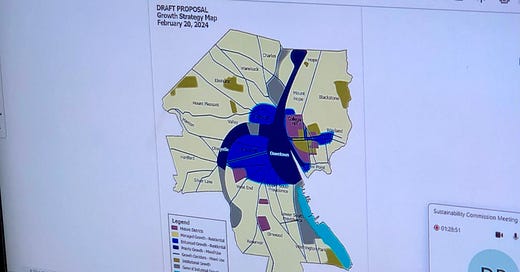Will Providence's Comprehensive Plan institutionalize climate and health injustices?
"I was alarmed to see this and want us to focus on it," said Julian Drix of the PVD Sustainability Commission. "To me, this is institutionalizing business as usual for another 10 years..."
At Monday evening's meeting of the Providence Sustainability Commission, Commission Chair Julian Drix provided a troubling update on the City of Providence's upcoming Comprehensive Plan. The Comprehensive Plan is the urban planning policy document that guides growth and development, produced once every decade by the City's Planning Department. The Comp Plan will help to shape the way the city develops over the next decade and be a vehicle for change - correcting for decades of climate, health, and housing injustices - or be a roadmap to exasperate existing traumas and inequalities within communities.
“We've been engaged in the comp plan for a while,” said Chair Drix. “The Comp Plan is in process and last week at the City Plan Commission the first draft of that was shared and will be shared in upcoming public hearings... There are a lot of pieces to the Comp Plan that are important [and] I think the most important piece is the land use maps. That's really where the vision for what type of uses we see on which kinds of land.
“What caught my eye was the generalized industrial growth areas that were shaded in gray. From my days in the health department running the asthma program, [these maps are] a one-to-one match with where the biggest asthma hotspots in Providence are. Those maps are included in the climate justice plan. Also, the Center for Disease Control created the first nationwide Environmental Justice Index Map a year or two ago. These [maps] compare the extent of environmental justice impacts across the country. The areas [in the proposed growth map] are in the top 10%, if not the top 5%, or even the top 1%, compared to all other census tracks nationwide. These are major environmental justice priority focus areas that are in the current draft of this plan slated for general industrial growth.
“I wanted to flag this for us. I know we have future follow-up [meetings] around the comp plan. When we met with Mayor Smiley and the City Council at the beginning of the term, this was an area that was brought up as something that we would be collaborating on and focusing on together. A lot of input has been shared already in the public engagement process around environmental justice and the Port of Providence in particular. But [the Industrial Growth Map] also includes areas along the 6/10 Connector and 146, the industrial freight corridors.
“I was alarmed to see this and want us to focus on it. To me, this is institutionalizing business as usual for another 10 years and we can't stand by that. That's my perspective. I wanted to bring it to everyone's attention and hear what people think about it. We can have future meetings around it. We can have Planning come back for more engagement and follow-up, but I just wanted to make sure that this was on people's radar as an upcoming issue and pass it over to staff for follow-up from Planning and what our engagement could look like.”
Priscilla De La Cruz, Providence Mayor Brett Smiley's Director of Sustainability, was at the meeting and explained that no one from Planning was available to answer Chair Drix's concerns at such short notice. She stressed that the process of incorporating sustainability and issues and concerns during the Comp Plan’s community engagement process is continuing.
That said, De La Cruz did not address the particulars of the map and the doubling down of industrialization in impacted climate justice communities.
Over at The Public's Radio, reporter Olivia Ebertz interviewed Deputy Director for Planning and Development Robert “Bob” Azar about the growth map, but the concerns of Chair Drix were not mentioned. In that interview, Azar noted that most of those areas designated as potential growth areas in the last Comp Plan did grow significantly.
“...those areas that we designated as ‘Growth Corridors’ saw a fair amoth,” said Azar. “A lot of that growth was spurred by market demand, but the regulations enabled that to happen.”
Vital Climate Justice legislation stalled in the Rhode Island General Assembly last year, passing the Senate but not the House. The purpose of Senator Dawn Euer's legislation is “to protect neighborhoods - particularly those with lower incomes, more minorities, and more people for whom English is not the primary language - from bearing outsized shares of the burden of pollution and environmental hazards from infrastructure and development.” In other words, the legislation seeks to protect the very communities being targeted by Providence's land use maps.
This is a developing story and will be closely tracked..





It will be very interesting to see how the City responds to suggests that there should not be a growth in pollution/industry in high asthma neighborhoods. Will they switch all focus to creating non polluting industry in those zones? Or will they same we need to grow industrial zones no matter what as we need the jobs? Which we all know is bogus thinking.